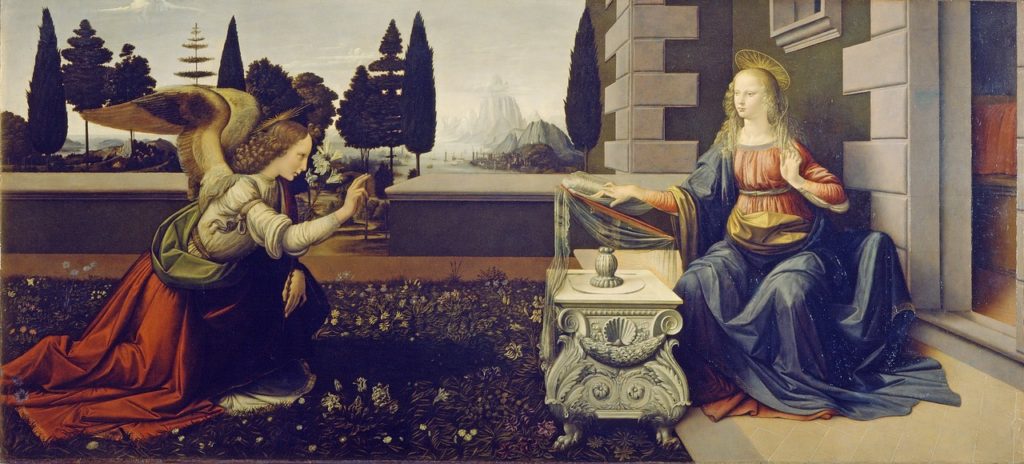The human form has often been the subject of great works of art. Consider Michelangelo’s renowned sculpture of David, or his depiction of The Creation of Adam – God the Father’s arm outstretched, his hand ready to impart a divine spark through touching Adam’s fingertip.
Leonardo da Vinci’s The Last Supper comes to mind—Christ the central and unifying figure amidst the twelve apostles in animated discussion.
How did these famous Renaissance artists produce such realistic masterpieces? In this period of history, live models posed for paintings and sculptures. However, some artists resorted to the use of bodies that had expired.
Both da Vinci and Michelangelo took dead bodies and dissected them. Skin was stripped away to understand the mysteries that lay beneath the surface. They threw themselves into studying human flesh, its supporting structures, blood and muscle, sinew and bone, and the rhythm and rhyme of the human form.
Artists often found it difficult to obtain suitable corpses for study, as grave robbing was commonplace.
In addition, medical professionals had priority over the use of corpses. These bodies were usually those of criminals, or the poor who died in hospitals with no family to claim them for burial. Doctors regularly performed public dissections and autopsies on these bodies at medical schools and universities all over Italy.
So how did the likes of Michelangelo obtain access to the deceased?
History tells us that at 17 years of age, Michelangelo sculpted a wooden crucifix for the high altar of the convent of Santa Maria del Santo Spirito. In exchange for his work, he obtained corpses to dissect from the convent’s hospital.
His passion to understand the shape of the human form and its appearance gave us one of the most beautiful sculptures in the world—the statue of David, in contrapposto pose. Michelangelo’s immersive anatomical research gave him the knowledge to produce David’s fascinating pose, the young man appears relaxed, yet also prepared for combat—his muscles at ease, but also ready for action.
How did Leonardo da Vinci source his corpses?
Da Vinci simply spent his time waiting around hospitals for people to die, so that he could cut open and study their remains.
He is the most significant artist-anatomist in history. Without his detailed study on human corpses, we would not have the Anatomical Manuscript A. In this, da Vinci produced 240 individual drawings with over 13,000 words of notes.
He devised useful techniques for depicted organs such as the “plan, section, and elevation” method. He also founded approaches to illustrating dissections such as depicting the cross section of muscles in layers.

Had Michelangelo and da Vinci been reluctant to handle dead bodies, we would not have their art, research or influence.
What if your house was filled with the bodies of the dead?
Before we examine our key text, let’s take a look at the events preceding the passage for some context.
While Jesus and his disciples were on a boat crossing the Sea of Galilee, a mighty windstorm struck. Naturally, the anxiety of his disciples escalated as the wind increased in intensity. Every one of them felt doomed to a watery grave, even their most experienced fishermen.
The boat rolled and pitched in the turbulent sea, but remarkably Jesus slept through the hurricane’s persistent tantrum. Out of fear and desperation, the disciples roused the Master. “Don’t you care that we’re about to die?”
Jesus got up from his makeshift bed. The boat lurched from side to side, and while the wind howled, he said to sea, “Peace be still.” Immediately, the wind stopped. The churning waves turned flat. All was calm.
In the blanket of silence that befell them, a question arose in their minds. Who was this man who could command the wind and the waves with the sound of his voice?
The windstorm took them from one side of the Sea of Galilee to the other, to the country of the Gerasenes near the village of Gergesa.
We pick up the story in Mark 5:1-20.
Jesus and his weary crew slowly disembarked from the battered ship. The disciples were relieved to plant their feet on the ground. In the distance, a man rushed to meet them. A man with an unclean spirit.
A man tormented
Shunned by a fearful community, this pathetic creature lived in the rocky hillside outside of town. There were numerous burial chambers carved into the sides of the mountains. It was within these tombs, these caves filled with dead bodies that this man called home.
The villagers made repeated attempts to restrain him with ropes before resorting to iron chains. However, the man’s abnormal strength snapped these heavy fetters like twigs. Nothing could subdue him.
And like a deranged beast, his wild shrieks and cries of torment echoed through those eerie tombs by night and day. His flesh was streaked with blood and gaping wounds from the sharp stones he used to mutilate himself.
As a man possessed, he was not capable of separating his own consciousness and thoughts from the influence of the demon. To outsiders, he was insane.
But when he saw Jesus afar off, he ran and worshipped him,
And cried with a loud voice, and said, What have I to do with thee, Jesus, thou Son of the most high God? I adjure thee by God, that thou torment me not.
For he said unto him, Come out of the man, thou unclean spirit.
And he asked him, What is thy name? And he answered, saying, My name is Legion: for we are many. Mark 5:6-9
The demon’s question
“What have I to do with thee, Jesus, thou Son of the most high God?” In other words, what did this legion of demons have in common with Jesus? Clearly, absolutely nothing.
They belonged to two diametrically opposed and radically different realms. Yet, the demon (the main spokesman for all the demons) acknowledged the true identity of Jesus—that he was God.
In his next breath, Legion begged for mercy, that he and the devils alongside him would not be thrown into the abyss.
And they besought him that he would not command them to go out into the deep. Luke 8:31
The ultimate fate of Satan and his demonic horde
Several passages provide us with more insight.
Then shall he say also unto them on the left hand, Depart from me, ye cursed, into everlasting fire, prepared for the devil and his angels: Matt 25:41
And the devil that deceived them was cast into the lake of fire and brimstone, where the beast and the false prophet are, and shall be tormented day and night for ever and ever. Rev 20:10
The devil and his wicked angels are cursed. The place prepared for them is the lake of fire where they will be tormented by everlasting fire.
The demons, a legion—meaning a military unit of between 4000 and 6000 infantry, did not want to be tormented before their time.
These demonic spirits needed living beings to inhabit, so they asked permission from Christ to enter the pigs. Namely, the swine grazing on the fertile plain near the mountains.

To a Jew, pigs were unclean animals and were not fit for eating. Therefore, the men tending this herd were either Gentiles or lapsed Jews unconcerned with God’s laws set out in Leviticus.
Jesus’ authority
Christ demonstrated his supreme power over these evil forces. By his permission, the raging demons abruptly departed from the man and entered the swineherd.
Overcome by the dark forces that invaded their bodies, the swine felt the sudden urge to flee. Their strained grunts, high-pitched squeals and the rumble of their hooves intensified in the night air. Overwhelmed, the pig herd ran violently down the steep bank into the sea.
Two thousand swine drowned that day, and their bloated carcasses bobbed up and down in the waves.
The spectacular sight reassured the man that Jesus had liberated him from demon possession. The foul spirits no longer had control of his mind and body. Jesus had set him free from the immensity of this evil.
A man at peace
Just like the calm after a storm, the man felt his thoughts quieten. The raging voices, the screaming control of the demons was no more.
The strange scene caused those who looked after the swine to run and tell all those in the city and country what they had witnessed. Those who heard went out to see for themselves what happened.
And they come to Jesus, and see him that was possessed with the devil, and had the legion, sitting, and clothed, and in his right mind: and they were afraid. Mark 5:15
Why were the people afraid? Were they afraid of Jesus and his unlimited and supreme power? Here was God in their midst, but they had no interest in honouring the Lord. Maybe they feared more loss of money and property. Perhaps they were afraid of his power. Either way, these people begged Jesus to leave their coasts.
Notice the healed man’s response. As Jesus was on the ship to depart, he begged Jesus that he might stay with him. He was not afraid; he loved Christ and wanted to remain at his side.
He wanted to be with the one who had seen his suffering and distress and did something about it. Christ had shown him mercy and great kindness.
But Jesus had other plans for this man. He invited him to share with others the good things God had done.
Howbeit Jesus suffered him not, but saith unto him, Go home to thy friends, and tell them how great things the Lord hath done for thee, and hath had compassion on thee. Mark 5:19
In obedience, the man witnessed to all who would hear in Decapolis, a Gentile region influenced by the Greek culture.
Should we who have also experienced Christ’s mercy and kindness do any less?
If the Son therefore shall make you free, ye shall be free indeed. John 8:36
Bibliography
Author unspecified. 2022, ‘Leonardo and Dissection’, Royal Collection Trust. Retrieved 27 July 2022 from
The Archaeology Study Bible, 2017, Crossway, Wheaton, Illinois.
Carlton, G. 2021, ‘Turns Out Michelangelo and Da Vinci Trafficked Dead Bodies for their Art’, Ranker.com. Retrieved 27 July 2022 from
https://www.ranker.com/list/anatomy-in-renaissance-art/genevieve-carlton
Edersheim, A. 2006. The Life and Times of Jesus The Messiah. Hendrickson Publishers. USA.
Henry, M. 1961, Commentary on the Whole Bible, Zondervan, Michigan.
Macarthur, J. 2019, The Macarthur Study Bible 2nd Edition, Thomas Nelson Publishers, China.
Pfeiffer C,F. 1990, The Wycliffe Bible Commentary, Moody Publishers, Illinois.
The Quest Study Bible, 1994, Zondervan Publishing House, Michigan.
Keener, C.1993, The IVP Bible Background Commentary New Testament, IVP Academic, Illinois.


